Autodesk’s Bifrost updates include virtual sliders for feedback port changes, unknown nodes for fixing broken graphs, expressive simulation graphs, and terminals for renderable geometry.
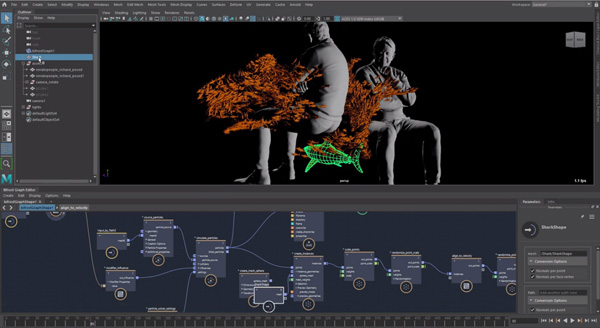
Bifrost’s Alembic integration corrects the handling of matrices and quaternions.
Autodesk Bifrost extension for Maya has updates that support artists creating and delivering complex simulations and custom effects. New Bifrost features include virtual sliders for fluid port changes, unknown nodes making it possible to fix broken graphs, more expressive simulation graphs, and terminals for renderable geometry, now out of beta.
New virtual sliders allow fluid ports to be adjusted in real-time, leaving dynamic constants and F-curves to be edited live. The ability to edit live simulations shortens the time between iterations, and by preserving feedback ports, artist simulations stay intact during graph edits, pausing and unpausing. Changing the parameters of the downstream node will not reset the simulated node.
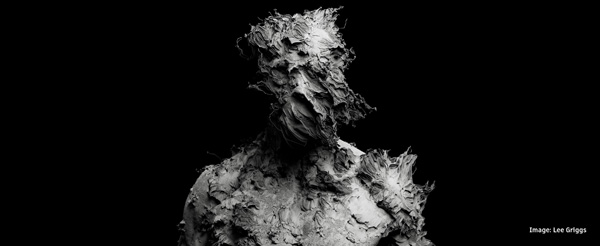
(Artist Lee Griggs)
Feedback ports can be used to cache the result of the last evaluation of a subgraph, and use it as the input for the next evaluation, which is essentially how simulations work – the result (output value) of one frame is the foundation (input) of the next frame.
Broken Bifrost graphs can now be fixed with unknown nodes, which means artists can work more confidently without as much concern for preserving graphs. Users can also merge JSON files into single large files, which speeds up loading and further improves time to first pixel in the first Arnold render in a session.
When a referenced compound is added that depends on unavailable nodes, the missing nodes are re-created as unknown nodes, preventing the graph from working. However, the external connections and input values of the unknown nodes are preserved, letting you see the graph as it existed before, to help fix or update it. The graph will work properly once the proper node definitions are available.
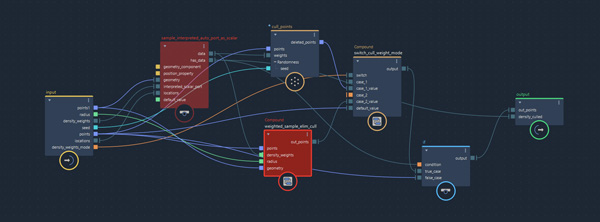
Broken Bifrost graphs can now be fixed with unknown nodes, shown in dark red.
Artists can now use fields and arrays to directly drive simulation parameters, making simulation graphics more expressive, readable and art directable. A variety of types may be plugged into certain properties of simulation sources to vary the properties at emission, for example, connecting a field to vary properties based on the field's values across space, or connecting an array of values to use as the values for emitted elements.
Bifröst Fluids Aero simulations are used to create effects like smoke, mist and other gases. The Aero solver’s post-simulation now only requires a single connection to make refinement workflows simpler. This way, the required data can be cached with the volume to perform a post-simulation refinement from disk, without the original simulation scene. This update has also improved MPM (Material Point Method) Cloth performance and simulation stability, as well as animation cloth and shell properties.
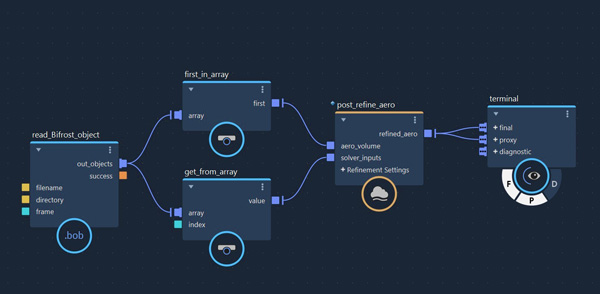
Terminals for renderable gometry are now out of beta.
Maya’s viewport display of adaptive volumes is also enhanced, and volume adaptivity can now be accessed on simulation compounds to improve performance for input meshes that require conversion. Adaptive volumes are used to automatically adjust the resolution in order to supply the most detail when and where it is needed. Non-adaptive volumes also now use the adaptive algorithm for accelerated conversions.
Bifrost’s Alembic integration now supports writing and reading for more Bifrost user data and corrects the handling of matrices and quaternions, which define how elements rotate in three dimensional space aound an arbitrary axis.
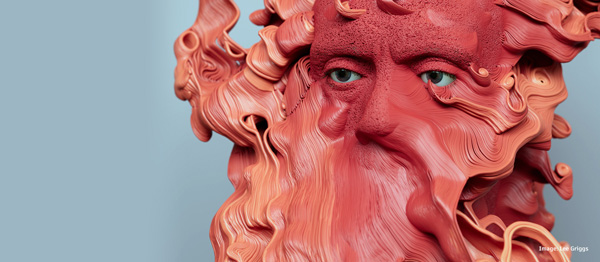
(Artist Lee Griggs)
Bugs associated with writing OpenVDB have also been corrected to make interacting with OpenVDB readers and writers more robust. Sparse OpenVDB files can be converted to adaptive Bifrost volumes.
With continued improvement since the initial release, terminals are now out of beta and ready for production. They are used as an alternative to output nodes for creating renderable geometry and can be used in nested compounds, not just the top level of the graph. Terminals now also work in loops, enabling each iteration to add geometry to a scene. www.autodesk.com


